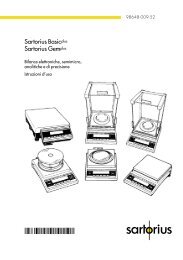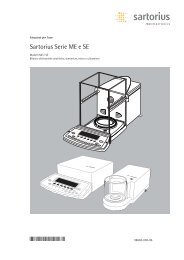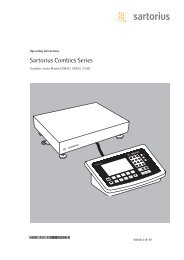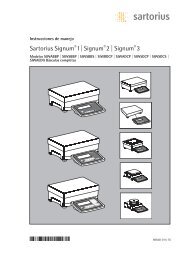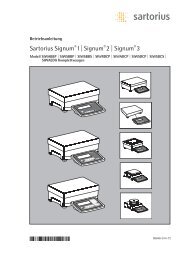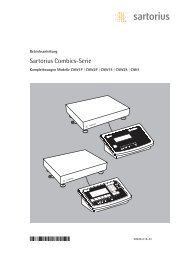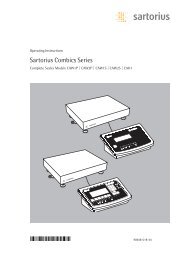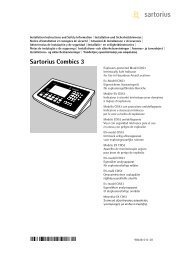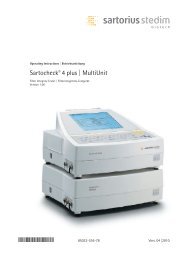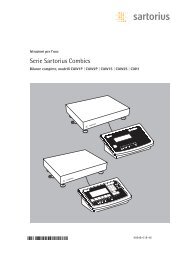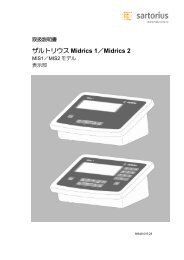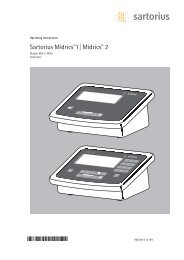Create successful ePaper yourself
Turn your PDF publications into a flip-book with our unique Google optimized e-Paper software.
Operating Instructions<br />
<strong>Sartobind</strong> STIC ® <strong>PA</strong><br />
pico 0.08 ml | nano 1 ml | 5" 70 ml | 10" 180 ml |<br />
30" 540 ml | mega 1.62 l<br />
A Separation Technology Based on<br />
Macroporous Membranes,<br />
4 mm Bed Height<br />
85032-540-59
Read operational instructions carefully before using <strong>Sartobind</strong> ® capsules.<br />
! Important<br />
Use of the product in applications not specified or not described<br />
in this manual, may result in improper function, personal injury,<br />
or damage of the product or material. The capsules are supplied as<br />
non-sterile. The membrane is dried from glycerol. Consider that<br />
polyvalent buffer ions such as phosphate or citrate may interfere<br />
with the binding of negatively charged molecules. For laboratory<br />
and research purposes only.<br />
Intended use<br />
The products should be used for flowthrough (negative) chromatography<br />
applications in single use to avoid carryover as well as tedious<br />
and costly cleaning validation procedure. <strong>Sartobind</strong> pico 0.08 ml is<br />
used for process development when smallest sample quantities are<br />
available only. <strong>Sartobind</strong> STIC ® <strong>PA</strong> nano 1 ml has been developed as<br />
a scouting device for working with small sample volumes while<br />
retaining the cylindrical design of large scale Membrane Adsorber.<br />
<strong>Sartobind</strong> STIC <strong>PA</strong> 5", 10", 30" and mega have been developed for<br />
intermediate and pilot scale up to production scale in the biopharmaceutical<br />
industry.<br />
2
Table of Contents<br />
1. Storage conditions 5<br />
2. Introduction 5<br />
3. Technical data 8<br />
4. Materials 10<br />
5. Binding capacity 11<br />
6. Installation 12<br />
7. Operation 15<br />
7.1 Venting 15<br />
7.2 Preconditioning 17<br />
7.3 Recommended<br />
flow rates 18<br />
7.4 Autoclaving 18<br />
7.5 Buffer conditions 19<br />
7.5.1 Selection of pH<br />
and salt conditions 20<br />
7.6 Sample preparation 21<br />
7.7 Contaminant removal<br />
form therapeutic<br />
proteins and other<br />
sources 22<br />
7.7.1 DNA removal 22<br />
7.7.2 Host cell protein<br />
removal 23<br />
7.7.3 Virus removal 24<br />
7.7.4 Endotoxin<br />
removal 25<br />
7.8 Draining 25<br />
7.9 Operation of the<br />
<strong>Sartobind</strong> ® pico and<br />
nano with peristaltic<br />
pumps or LC systems 26<br />
7.10 Scaling up 27<br />
3
8. Diffusion test 30<br />
8.1 Installation for test 30<br />
8.2 Operation of test 30<br />
8.2.1 Pre-washing of capsule 30<br />
8.2.2 Diffusion measurement<br />
with Sartocheck ® 4 Plus 32<br />
8.2.3 Result and evaluation 33<br />
4<br />
9. Troubleshooting 34<br />
10. Quality assurance 38<br />
11. Ordering information 39<br />
11.1 Capsules 39<br />
11.2 Accessories 41<br />
12. Dimensions and<br />
connections 42
1. Storage conditions<br />
<strong>Sartobind</strong> capsules should be stored clean dry and away from direct<br />
sunlight in the box at room temperature.<br />
2. Introduction<br />
<strong>Sartobind</strong> STIC <strong>PA</strong> is a salt tolerant anion exchange chromatography<br />
membrane. It can be used in the downstream processing of biomolecules<br />
e.g. proteins or viruses. The anion exchange ligands are coupled to<br />
a cellulose membrane which is fitted into a plastic housing for quick<br />
handling, making ion exchange purification nearly as easy as filtration.<br />
The product is intended for single use and can be applied for contaminant<br />
removal from proteins in flowthrough mode (negative chromatography)<br />
to bind DNA, residual protein, host cell proteins, endotoxins and<br />
viruses.<br />
5
Fig. 1:<br />
<strong>Sartobind</strong> STIC<br />
<strong>PA</strong> pico 0.08 ml<br />
6<br />
Fig. 2:<br />
<strong>Sartobind</strong> STIC <strong>PA</strong> nano 1 ml, 5" and 10" capsules.<br />
The arrows indicate the vent valves. For 10" an<br />
optional stainless steel holder is available (see fig. 3).<br />
L<br />
L<br />
L<br />
L
Fig. 3: 30 inch capsule Fig. 4: Mega with stainless<br />
on stainless steel holder steel legs (accessory)<br />
(accessory)<br />
7
3. Technical Data<br />
Type Anion exchanger<br />
Bed height 4 mm<br />
Membrane volume|area pico capsule 0.08 ml|2.9 cm 2<br />
Membrane volume|area nano capsule 1 ml|36 cm 2<br />
Membrane volume|area 5" capsule 70 ml|0.25 m 2<br />
Membrane volume|area 10" capsule 180 ml|0.66 m 2<br />
Membrane volume|area 30" capsule 540 ml|2 m 2<br />
Membrane volume|area mega capsule 1620 ml|6 m 2<br />
Typical dynamic binding capacity* 1.4 mg/cm 2<br />
at 10% breakthrough for bovine 50 mg/ml<br />
serum albumin in 20 mM Tris/HCl<br />
buffer pH 7.5, 150 mM NaCl<br />
Charge density 18–22 μeq/cm 2<br />
Recommended flow rate*** 10–30 membrane<br />
volumes per minute<br />
8
Maximum pressure at 20°C 4 bar (0.4 Mpa, 58 psi),<br />
5″ capsule<br />
5 bar (0.5 MPa, 73 psi)<br />
Pico unit<br />
6 bar (0.6 MPa, 88 psi)<br />
Maximum pressure during venting**** 0.5 bar, 0.05 MPa, 7 psi<br />
Short term** pH stability 2–14<br />
Chemical stability Stable against commonly<br />
used buffers in chromatography.<br />
Avoid oxidizing<br />
agents. Discard after one use<br />
* See also section 5. Binding capacity<br />
** Short term refers to CIP procedure described in section 6.3 Sanitization<br />
*** See also section 7.3 Recommended flow rates<br />
**** Venting not valid for Pico/Nano (handling by syringe)<br />
9
4. Materials<br />
Housing Polypropylene<br />
Membrane matrix Stabilized reinforced cellulose,<br />
nominal pore size >3 μm<br />
Ligand Primary amine (<strong>PA</strong>)<br />
Membranes are dried from glycerol to avoid shrinking.<br />
10
5. Binding capacity<br />
Typical dynamic binding capacity at 10% breakthrough is determined<br />
as 1.4 mg/cm 2 with BSA (bovine serum albumin) by using<br />
3 layers of 5 cm 2 membrane discs (15 cm 2 total area) stacked into<br />
a holder and run at 10 ml/min with 20 mM Tris/HCl pH 7.5,<br />
150 mM NaCl buffer.<br />
Unit area Typical dynamic binding<br />
capacity 10% | capsule<br />
<strong>Sartobind</strong> STIC <strong>PA</strong> pico 0.08 ml 2.9 cm 2 4 mg<br />
<strong>Sartobind</strong> STIC <strong>PA</strong> nano 1 ml 36 cm 2 50 mg<br />
<strong>Sartobind</strong> STIC <strong>PA</strong> 5" 70 ml 2500 cm 2 3.5 g<br />
<strong>Sartobind</strong> STIC <strong>PA</strong> 10" 180 ml 6600 cm 2 9.2 g<br />
<strong>Sartobind</strong> STIC <strong>PA</strong> 30" 540 ml 2 m 2 28 g<br />
<strong>Sartobind</strong> STIC <strong>PA</strong> mega 1.62 l 6 m 2 83 g<br />
11
6. Installation<br />
The contents of the package are described in chapter 10, page 38.<br />
When unpacking capsules, protect the inlet and outlet connectors<br />
from damage.<br />
The <strong>Sartobind</strong> SingleSep capsules should be installed in an upright<br />
position - inlet up - in the process flow as indicated by an arrow on<br />
the capsule.<br />
Install the capsule in-line with the appropriate connectors<br />
<strong>Sartobind</strong> mega<br />
Lay down the mega capsule first and connect stainless steel legs<br />
before set up. Never keep or place capsules on connectors. Store<br />
items securely and never in upright position. The mega carries protective<br />
caps on inlet, outlet and vent valves. Remove before venting.<br />
Stainless Steel holders<br />
For the 10, or 30 inch capsules a stainless steel holder.<br />
Stainless steel legs are available for the mega (see figure 3).<br />
For the holders and legs see chapter 10. Accessories.<br />
12
Flow direction<br />
In <strong>Sartobind</strong> pico the flow is from top through 4 mm membrane<br />
bed to the outlet.<br />
Fig. 5: Flow pattern inside <strong>Sartobind</strong> pico capsule<br />
The flow pattern inside the capsule is from outside of the membrane<br />
cylinder through the membrane bed to the inside and to outlet.<br />
13
Fig. 6: Flow direction inside nano to mega capsules<br />
! Important note<br />
Capsules should be visually inspected before use. In case of damage,<br />
the capsule has to be replaced. Close vent valves before use by<br />
screwing the valve in clockwise.<br />
14
7. Operation<br />
7.1 Venting<br />
It is important to remove air from the unit completely. For the nano<br />
and pico fill a 10–20 ml Luer syringe with equilibration buffer and<br />
connect to the nano capsule. Hold capsule upright (outlet is up) and<br />
expel air as shown in Fig. 7. If you still detect any air in the filled<br />
unit, close the outlet, hold the syringe up and move the plunger<br />
slightly up and down that air bubbles can ascend into the syringe.<br />
Very small air bubbles observed directly below the inlet of the nano<br />
do not disturb separations. The capsule will function normally as<br />
long as the small air bubbles remain outside of the membrane bed.<br />
For the pico removal of air is critical. Expel air as in Fig. 7 and connect<br />
syringe at outlet and purge again.<br />
15
Fig. 7: Filling the <strong>Sartobind</strong> nano<br />
with a Luer syringe<br />
The 5, 10, 30 inch and mega capsules carry vent valves with hose<br />
barb connectors for the fluid spilled out during venting. Before<br />
opening the vent valve, please connect the valves by flexible tubes<br />
(inner diameter 6 mm) to waste. During venting please do not<br />
exceed 0.05 MPa pressure as the vent valve O-ring could change<br />
its position which will result in insufficient closing of the valve.<br />
For appropriate venting, open the vent valve screw 1/3 turn to<br />
left until all air is replaced by fluid.<br />
16<br />
Outlet<br />
Inlet
7.2 Preconditioning<br />
Prior to sample loading, a sanitization and flushing procedure<br />
is recommended.<br />
1. For sanitization use 30 membrane volumes (MV) of 1 N NaOH<br />
solution at a flow rate of 1 MV/min.<br />
2. Flush with 100 MV of equilibration buffer (e.g. 20 mM Tris/HCl,<br />
150 mM NaCl, pH 7.5) at 5 MV/min.<br />
Specifically for the pico a sufficient flushing with equilibration<br />
buffer is required to stabilize the pH value. Due to the void volume<br />
of the FPLC system NaOH residue could lead to a pH shift. In that<br />
case more flushing volume after a sanitization is needed.<br />
17
7.3 Recommended flow rates<br />
Membrane adsorbers can be run at much higher flow rate per volume<br />
than columns. The recommended flow rates for membrane<br />
adsorbers are between 10 to 30 membrane volumes per minute.<br />
This recommendation is only a guideline since buffers and samples<br />
have different compositions and viscosities. Please test your planned<br />
flow rates using a small scale device to ensure that they fit into your<br />
pump capacities and pressure limits. Membranes can be operated<br />
also at lower flow rates without any loss of performance if the pump<br />
capacity is not sufficient to reach high flow rates. Please consider<br />
that lowering the flow rate will not improve binding capacity.<br />
7.4 Autoclaving<br />
The cylindricalcapsules can be autoclaved once at 121°C for<br />
30 minutes at 1 bar (0.1 MPa | 14.5 psi). Prewet the capsule with<br />
equilibration buffer. You may use water or buffer for pre-wetting.<br />
Close valves immediately after sterilisation. For autoclaving <strong>Sartobind</strong><br />
mega refer to separate autoclaving instruction enclosed in delivery.<br />
18
7.5 Buffer conditions<br />
Ionic strength of buffers during loading can be much higher than<br />
for conventional anion exchange Membrane Adsorbers. The pKa of<br />
the chosen buffer should not exceed ± 0.5 pH units of the operation<br />
pH. It should be filtered with 0.2 μm filters before use and the<br />
quality of water and chemicals should be of high purity.<br />
! Important<br />
It is recommended to use monovalent buffers e.g. TRIS or Acetate.<br />
Multivalent buffers like phosphate or citrate can reduce binding<br />
capacity for proteins. On the other hand, contaminants such as DNA<br />
and endotoxin can still bind at low concentration of mulitivalent<br />
salts to achieve even better separation of target molecules from<br />
contaminants. The buffering ion should carry the same charge as<br />
the ion exchange ligand.<br />
19
7.5.1 Selection of pH and salt conditions<br />
In ion exchange chromatography a charged molecule is bound to<br />
oppositely charged groups attached to the insoluble matrix. This<br />
binding is reversible by application of salt ions to the buffer eluting<br />
the molecule. The pH value at which a biomolecule has no net<br />
charge is the isoelectric point: pI. If the pH of the buffer is below<br />
the isoelectric point (rule of the thumb at least 1 pH unit) a protein<br />
for example carries a positive net charge and will bind to a cation<br />
exchanger (<strong>Sartobind</strong> S). If the pH of the buffer is above its isoelectric<br />
point (at least 1 pH unit) it will bind to anion exchangers<br />
(<strong>Sartobind</strong> Q or <strong>Sartobind</strong> STIC <strong>PA</strong>).<br />
Consider the character of the amine ligand of <strong>Sartobind</strong> STC <strong>PA</strong><br />
as a weak anion exchanger. It means that approaching higher<br />
pH the positive charge lowers. To optimize the binding capacity<br />
and load volume, multiple pH values should be tested (e.g. 96 well<br />
plates).<br />
20
Conventional ion exchangers are loaded at low conductivity.<br />
Proteins are easily eluted by adding e.g. 1 M NaCl. <strong>Sartobind</strong> STIC <strong>PA</strong><br />
binding is also influenced by salt but higher levels of salt are needed<br />
to elute the molecules. At a level of e.g. 150 mM NaCl where conventional<br />
anion exchanges do not bind, the salt tolerant membrane<br />
shows good binding capacity. To remove protein from the membrane,<br />
higher salt concentration than for conventional ion exchanger<br />
shall be needed.<br />
7.6 Sample preparation<br />
The sample should be adjusted to the starting buffer conditions and<br />
be prefiltered through a 0.2 μm membrane filter.<br />
! Important<br />
Unfiltered feed might block the Membrane Adsorber and lead to<br />
capacity loss and increased back pressure.<br />
21
7.7 Contaminant removal form therapeutic proteins<br />
and other sources<br />
For contaminant removal from products such as monoclonal antibodies,<br />
pH conditions in the range of pH 6 to 8 should be used.<br />
Contaminants include highly negatively charged DNA, endotoxins,<br />
protein contaminants, some host cell proteins and viruses. The<br />
product of interest, the monoclonal antibody, having a pI above<br />
the pH of the buffer, will not bind and pass through the anion<br />
exchanger. The influence of the flow rate is very low. Use recommended<br />
flow rates whenever possible. Lower flow rates do not<br />
affect the removal rate.<br />
Note the buffer conditions described in 7.5.<br />
7.7.1 DNA removal<br />
DNA displays a highly negative charge at neutral pH. DNA binding<br />
capacity of <strong>Sartobind</strong> STIC at 150 mM NaCl in 20 mM Tris/HCl and<br />
150 mM NaC is approximately 0.3 mg/ cm 2 or 10 mg/ml. DNA<br />
removal can be achieved in a broad range of buffer pH and conductivities.<br />
22
7.7.2 Host cell protein removal<br />
During cell culture of Chinese hamster ovary (CHO) cells, proteins<br />
with different isoelectric points are present in the cell culture broth.<br />
As described for most proteins, the isoelectric point is predominantly<br />
below 7. That is the reason why most of host cell proteins bind at<br />
a pH between 7 and 8 1 . The pH of the buffer has a great influence<br />
on the binding of CHO proteins as a slight change towards alkaline<br />
pH can improve the binding capacity drastically (see also chapter<br />
7.5.1 Selection of pH and salt conditions). Below 6.5 the binding of<br />
host cell proteins drops 10–20% with each 0.5 pH step. <strong>Sartobind</strong> STIC<br />
with primary amine ligand tolerates higher salt concentrations than<br />
a conventional Membrane Adsorber. It will bind negatively charged<br />
molecules at high conductivity of 20 mS/cm. Thus it can be used<br />
e.g. for cation exchange elution pools with less or without further<br />
dilution. Host cell protein removal can reach up to >3 LRV at a<br />
protein loading (e.g. Mabs) of 10 kg per liter membrane.<br />
1 Gianazza, E. and Righetti, P.G. J. Chromatography 193 (1980) 1-8<br />
23
7.7.3 Virus removal<br />
Anion exchange chromatography is a method for the removal of<br />
adventitious and endogenous viruses during the downstream processing<br />
of pharmaceutical proteins. A number of model viruses<br />
behave similar to proteins and can be charged negatively to bind<br />
onto an anion exchanger. The removal performance is tested by<br />
spiking of DNA/RNA model viruses into the protein solutions. Ideal<br />
binding conditions are typically found in virus spiking studies while<br />
varying the pH (e.g. 6.5–8.0) and the conductivity (up to 20 mS/cm).<br />
Due to the <strong>Sartobind</strong> STIC capability to work at higher conductivity,<br />
effective MVM (Minute Virus of Mice) removal of >4 LRV has been<br />
achieved at 16 mS/cm. <strong>Sartobind</strong> STIC allows a load capacity of<br />
10–20 kg antibody per liter Membrane Adsorber while the virus<br />
clearance is maintained.<br />
24
7.7.4 Endotoxin removal<br />
Endotoxins are lipopolysaccharides from cell walls of Gram negative<br />
bacteria and make up the majority of pyrogens in pharma products.<br />
They must be removed to typically
7.9 Operation of the <strong>Sartobind</strong> pico and nano capsules with<br />
peristaltic pumps or LC systems<br />
To prepare the LC system for use with the <strong>Sartobind</strong> pico device,<br />
measure the systems flow rate per minute – e.g. with a graduated<br />
cylinder at the chosen flow rate. This prevents deviations of pico<br />
break through measurements to binding capacity results with the<br />
larger capsules. The <strong>Sartobind</strong> pico and nano device should be filled<br />
as described in chapter 7.1 (page 15). Start the LC system or peristaltic<br />
pump at a low flow rate. When fluid emerges, stop the pump,<br />
connect the tubing to the inlet of the <strong>Sartobind</strong> pico or nano. Make<br />
sure that no air is introduced. Remove the cap from outlet. Run the<br />
pump until fluid emerges from the outlet of the unit and stop it.<br />
Then connect the outlet of the unit via Luer adapter to the LC detector<br />
and proceed with loading. If your system pressure is too high,<br />
refer to your LC system manual to remove any flow restrictor after<br />
the UV cell, as the system may generate a pressure above the allowed<br />
maximum pressure. As Membrane Adsorbers run typically at much<br />
higher flow rates than columns, there is no risk of bubble formation<br />
in the UV cell when removing the restrictor.<br />
26
7.10 Scaling up<br />
Complete the break through experiments for the target compound to<br />
be bound on the membrane matrix. After optimisation of binding<br />
conditions for the contaminants, the purification step can be scaled<br />
up to a larger capsule.<br />
Recommendations<br />
Maintain:<br />
– Bed height (automatically kept constant when using capsules<br />
with same bed height)<br />
– Linear flow (automatically kept constant when using capsules<br />
with same bed height)<br />
– Sample concentration<br />
Increase:<br />
– Sample loading volumes<br />
– Volumetric flow rate<br />
– Membrane volume<br />
Scale up calculations are done preferably by the membrane volume<br />
as the calculation is most simple. Other methods for scale up via<br />
residence time will lead to same result. Using the <strong>Sartobind</strong> nano<br />
1 ml the scale up factor for flow rate and binding capacity is equal<br />
to the membrane volumes of the target scale up device.<br />
27
Device Bed Factor to Factor to<br />
volume increase increase<br />
[ml] flow rate binding<br />
(from nano) capacity<br />
(from nano)<br />
Pico 0.08 – –<br />
Nano 1 1 1<br />
5 inch 70 70 70<br />
10 inch 180 180 180<br />
30 inch 540 540 540<br />
Mega 1620 1620 1620<br />
Example: After breakthrough experiments with the nano you found<br />
500 fold binding capacity is needed. You will choose the 30 inch<br />
capsule. Then increase flow rate by a factor of 540.<br />
28
! Important<br />
Keep sample concentration constant in lab and production scale.<br />
Watch out for volumes in the piping and flow rate in whole system.<br />
When using the <strong>Sartobind</strong> pico for scale up calculations smallest<br />
deviation in flow rate or incorrectly given void volume of the<br />
FPLC System may have a severe impact on the scale up calculation.<br />
Use the nano as intermediate scale up control.<br />
29
8. Diffusion test of 5”, 10", 30" and mega capsules<br />
The integrity of the capsule can be controlled by a diffusion test.<br />
The testing procedure describes the diffusion test for pre and<br />
post use. The test is intended to discriminate between defective<br />
and intact capsules and to detect major bypasses, large holes and<br />
faulty assembly. Smaller capsules than 5" cannot be tested due<br />
to technical reasons.<br />
8.1 Installation for test<br />
Test procedure has been generated with current Sartocheck instrument<br />
family e.g. Sartocheck 4 Plus (26288) or 3 Plus (16290).<br />
Use of earlier Sartocheck instruments will generate faulty data.<br />
Install capsule as shown in Fig. 6.<br />
Please note that the test procedure with other vendor's integrity<br />
testers can require a different set up.<br />
8.2 Operation of test<br />
8.2.1 Pre-washing of capsule<br />
Pre-wash with 30 membrane volumes (MV) of water at flow rate<br />
of 10 MV/min.<br />
30
! Important<br />
The capsule needs to be pre-washed with the testing solvent, to<br />
remove any glycerol. The washing solution should be at room temperature.<br />
Keep the unit in an upright position for proper venting and<br />
open the vent screw on top of the unit until all air is replaced by<br />
testing solvent.<br />
Compressed Air<br />
3–10 bar<br />
Vent valve<br />
Membrane<br />
Adsorber<br />
Open to<br />
atmosphere<br />
Fig. 8: Set up of diffusion test with Sartocheck 4 Plus or 3 Plus<br />
31
8.2.2 Diffusion measurement with Sartocheck ®<br />
Choose PROGRAMMING in the main menu<br />
Choose DIFFUSION TEST<br />
Test parameters<br />
Test pressure: 100 mbar (1.4 psi)<br />
Stabilisiation time: 2 min (5″ and 10″), 3 min (30″ and mega)<br />
Testing time: 1 min<br />
Diffusion max (ml/min): 10 (5″), 15 (10″), 50 (30″), 150 (mega)<br />
Net volume: If this value is set to zero, Sartocheck ® automatically<br />
measures the dead volume.<br />
32
8.2.3 Results and evaluation<br />
– Diffusion < Diffusion max<br />
Test passed (diffusion value on the print out)<br />
– Diffusion > Diffusion max<br />
Test failed (red text on the print out)<br />
33
9. Troubleshooting<br />
Problem Possible cause Action<br />
Break through LC pump Control flow rate of chromatography<br />
data of delivers pump with a graduated cylinder<br />
<strong>Sartobind</strong> pico different flow and correct the system to desired<br />
do not fit rate than flow rate.<br />
to larger indicated or Check system void volume and<br />
capsules given void enter the correct value.<br />
volume of<br />
the LC system<br />
is incorrect.<br />
34
Problem Possible cause Action<br />
Air bubbles Incomplete air Small air bubbles seen in the<br />
can be seen removal top of the unit do not interfere with<br />
the purification as long as they do<br />
not touch the membrane bed. If too<br />
much air is enclosed, repeat removal<br />
as described in chapter 6.1 Venting.<br />
I installed Installation Validation has been done with a<br />
the capsule of capsule process flow from top to bottom.<br />
upside down may be Thus it is clearly recommended<br />
easier in to use capsules in the described<br />
the process flow direction (Feed enters<br />
flow capsule on top and leaves<br />
on the bottom).<br />
35
Problem Possible cause Action<br />
High back Material has Prefilter with 0.2 μm filter<br />
pressure not been before processing through the<br />
during sample filtered unit.<br />
loading<br />
Material has Proteins can form aggregates<br />
been filtered within hours or during<br />
but was stored operation. Thus we recommend<br />
before to prefilter inline by attaching a<br />
purification 0.2 μm filter in front of the adsorber.<br />
When you observe again<br />
pressure built up, replace the filter.<br />
LC system Remove restrictor after the<br />
generates high UV cell.<br />
pressure<br />
The adsorber Replace unit<br />
is clogged<br />
36
Problem Possible cause Action<br />
Target mole- Conditions for Control pH and salt concentration<br />
cule is not binding are and keep temperature constant<br />
bound insufficient (pH change). <strong>Sartobind</strong> STIC membrane<br />
is salt tolerant but lower salt<br />
concentrations allow higher binding<br />
capacity.<br />
Binding Process Process conditions, e.g. prefiltration,<br />
capacity is conditions not pH, conductivity, multivalent<br />
not sufficient optimized buffers etc. have to be checked and<br />
optimized.<br />
Incomplete Strong binding Use capsule only once.<br />
elution<br />
37
10. Quality assurance<br />
This product is tested for protein dynamic binding capacity and<br />
flow rate. <strong>Sartobind</strong> membranes have been tested for protein<br />
dynamic binding capacity, flow rate, thickness, and charge density.<br />
Capsules and membranes are manufactured in a controlled<br />
environment. The product meets all <strong>Sartorius</strong> Stedim Biotech<br />
standards for traceability, production and specifications as given<br />
here or exceeded them as certified in the quality assurance<br />
certificate enclosed. The validation guide is available on request.<br />
38
11. Ordering information<br />
11.1 Capsules<br />
Order number Description and type of connectors Quantity<br />
92ST<strong>PA</strong>42DD-11--D <strong>Sartobind</strong> STIC <strong>PA</strong> pico 0.08 ml<br />
Luer female<br />
2 adapters Luer male to<br />
UNF 10-32 female, PEEK<br />
Manual, certificate<br />
10<br />
92ST<strong>PA</strong>42DN-11--A <strong>Sartobind</strong> STIC <strong>PA</strong> nano 1 ml,<br />
Luer female<br />
2 adapters Luer male to<br />
UNF 10–32 female, PEEK<br />
Manual, certificate<br />
4<br />
5" capsule 70 ml, 2500 cm2 92ST<strong>PA</strong>42D9-FF--A <strong>Sartobind</strong> STIC <strong>PA</strong> 5" capsule<br />
3/4" santary clamp,<br />
manual, certificate<br />
4<br />
39
Order number Description and type of connectors Quantity<br />
10" capsule 180 ml, 6600 cm2 92ST<strong>PA</strong>42D1-SS <strong>Sartobind</strong> STIC <strong>PA</strong> 10" capsule<br />
1 1/2" sanitary clamp,<br />
manual, certificate<br />
1<br />
30" capsule 540 ml, 2 m2 92ST<strong>PA</strong>42D3-SS <strong>Sartobind</strong> STIC <strong>PA</strong> 30" capsule<br />
1 1/2" sanitary clamp,<br />
manual, certificate<br />
1<br />
Mega capsule 1.62 l, 6 m2 92ST<strong>PA</strong>42DC3SS <strong>Sartobind</strong> STIC <strong>PA</strong> mega capsule<br />
1 1/2" sanitary clamp,<br />
2 manuals, certificate<br />
1<br />
40
11.2 Accessory<br />
Order number Description Quantity<br />
1ZA---0004 Adapter Luer male to 1<br />
UNF-10 – 32 female, PEEK<br />
1ZAOGV0003 Adapter UNF 10–32 female 2<br />
to 25 mm, sanitary,<br />
polyoxymethylene<br />
9ZAIAM0001 Stainless steel legs for mega 3<br />
5ZGI--0001 Holder for 1+ 10", 20" or 1<br />
30" capsule, stainless steel, 3 legs<br />
5ZALB-0002 Distribution adapter for 1<br />
3 capsules, stainless steel<br />
5ZGLG-0004 Holder for 3+10", 20" and 1<br />
30" capsules, stainless steel, 3 legs<br />
7ZAL-V0013 Reducing adapter 11"–3"; 2<br />
50.5/25 mm, sanitary<br />
7ZAL-V0010 Reducing adapter 2"–11"; 2<br />
64/50.5 mm, sanitary<br />
41
12. Dimensions and Connections<br />
<strong>Sartobind</strong> STIC <strong>PA</strong> 4 mm pico nano<br />
This side up<br />
Direction of flow ↓<br />
Connector Luer Lok Luer Lok<br />
Dimensions (height + diameter) 31+11 mm 37+33 mm<br />
Approximate capsule weight 1.5 g 10 g<br />
Frontal surface area (cm 2 ) 0.19 2.4<br />
Connectors female female<br />
42
5" 10", 30" mega<br />
Sanitary 3" Sanitary 1 1" Sanitary 1 1"<br />
197+77 mm 365+100 mm (10") 910+190 mm<br />
870+100 mm (30")<br />
0.2 kg 0.8 | 2 kg 5.6 kg<br />
160 450| 1350 4050<br />
25 mm outer 50.5 mm outer 50.5 mm outer<br />
15.8 mm inner 36 mm inner 36 mm inner<br />
diameter diameter diameter<br />
43
<strong>Sartobind</strong> STIC <strong>PA</strong> 4 mm pico nano<br />
Gaskets – –<br />
For more information about validation service and other Membrane<br />
Adsorber types please contact your local <strong>Sartorius</strong> Stedim Biotech<br />
representative or visit our homepage.<br />
44
5" 10", 30" mega<br />
3”, internal 1 1", internal 1 1", internal<br />
diameter diameter diameter<br />
16 mm 35.8 mm 35.8 mm<br />
45
<strong>Sartorius</strong> Stedim Biotech GmbH<br />
August-Spindler-Strasse 11<br />
37079 Goettingen, Germany<br />
Phone +49.551.308.0<br />
Fax +49.551.308.3289<br />
www.sartorius-stedim.com<br />
First published:<br />
July, 15 2011<br />
<strong>Sartorius</strong> Stedim Biotech GmbH,<br />
Goettingen, Germany<br />
Copyright by <strong>Sartorius</strong> Stedim Biotech<br />
GmbH, Goettingen, Germany.<br />
All rights reserved. No part of this<br />
publication may be reprinted or<br />
translated in any form or by any<br />
means without the prior written<br />
permission of <strong>Sartorius</strong> Stedim Biotech<br />
GmbH. The status of the information,<br />
specifications and illustrations in this<br />
manual is indicated by the date given<br />
below. <strong>Sartorius</strong> Stedim Biotech GmbH<br />
reserves the right to make changes to<br />
the technology, features, specifications<br />
and design of the equipment without<br />
notice. Luer Lok is a trademark of<br />
Becton, Dickinson and Company.<br />
<strong>Sartobind</strong> ®, <strong>Sartobind</strong> STIC ®,<br />
Sartocheck and Minisart are trademarks<br />
of <strong>Sartorius</strong> Stedim Biotech<br />
GmbH. Printed in Germany on paper<br />
that has been bleached without any<br />
use of chlorine.<br />
Printed in Germany on paper that<br />
has been bleached without any use<br />
of chlorine<br />
W · <strong>Sartobind</strong> STIC<br />
Publication No.: SL-6175-e11092<br />
Ver. 09 | 2011



